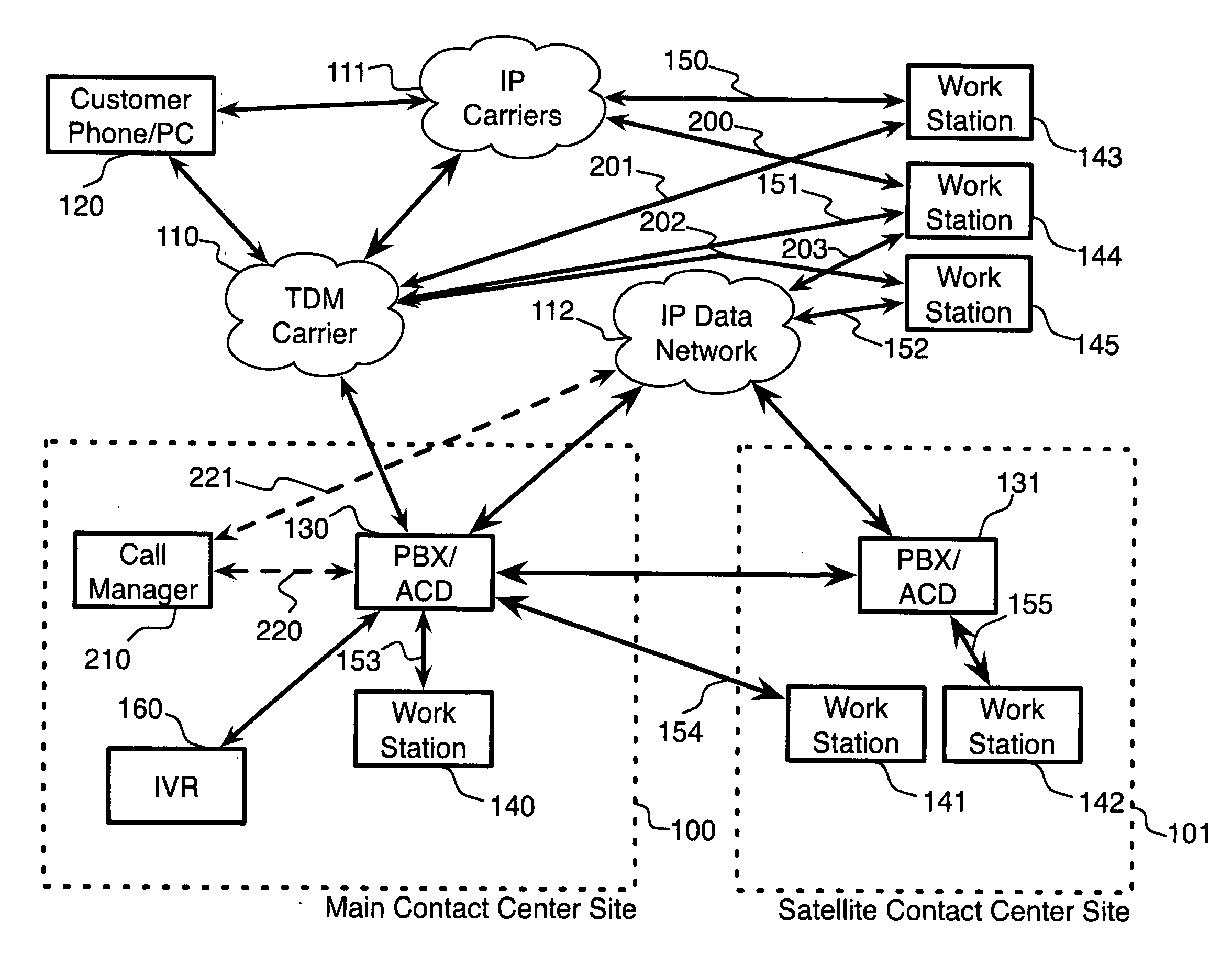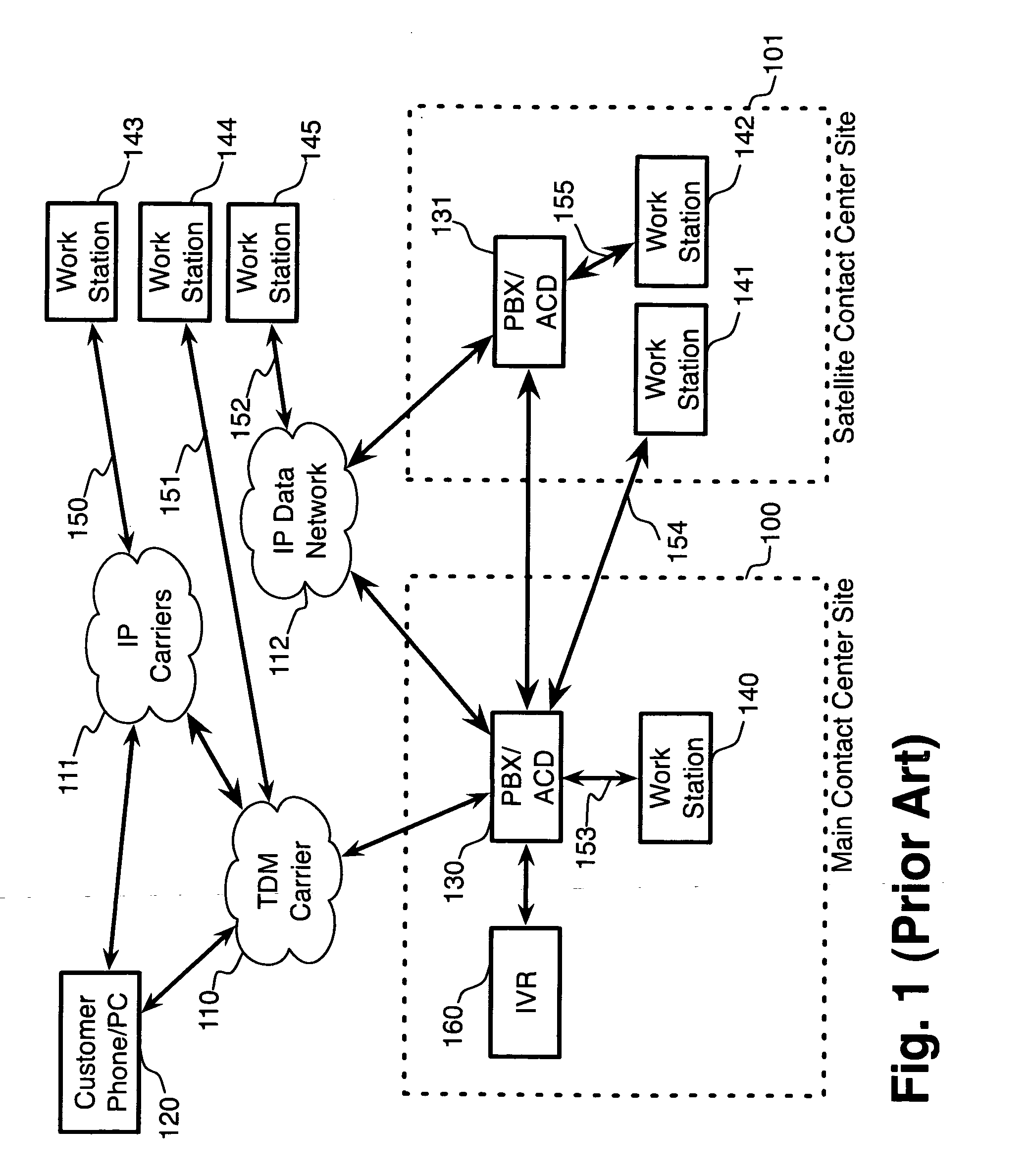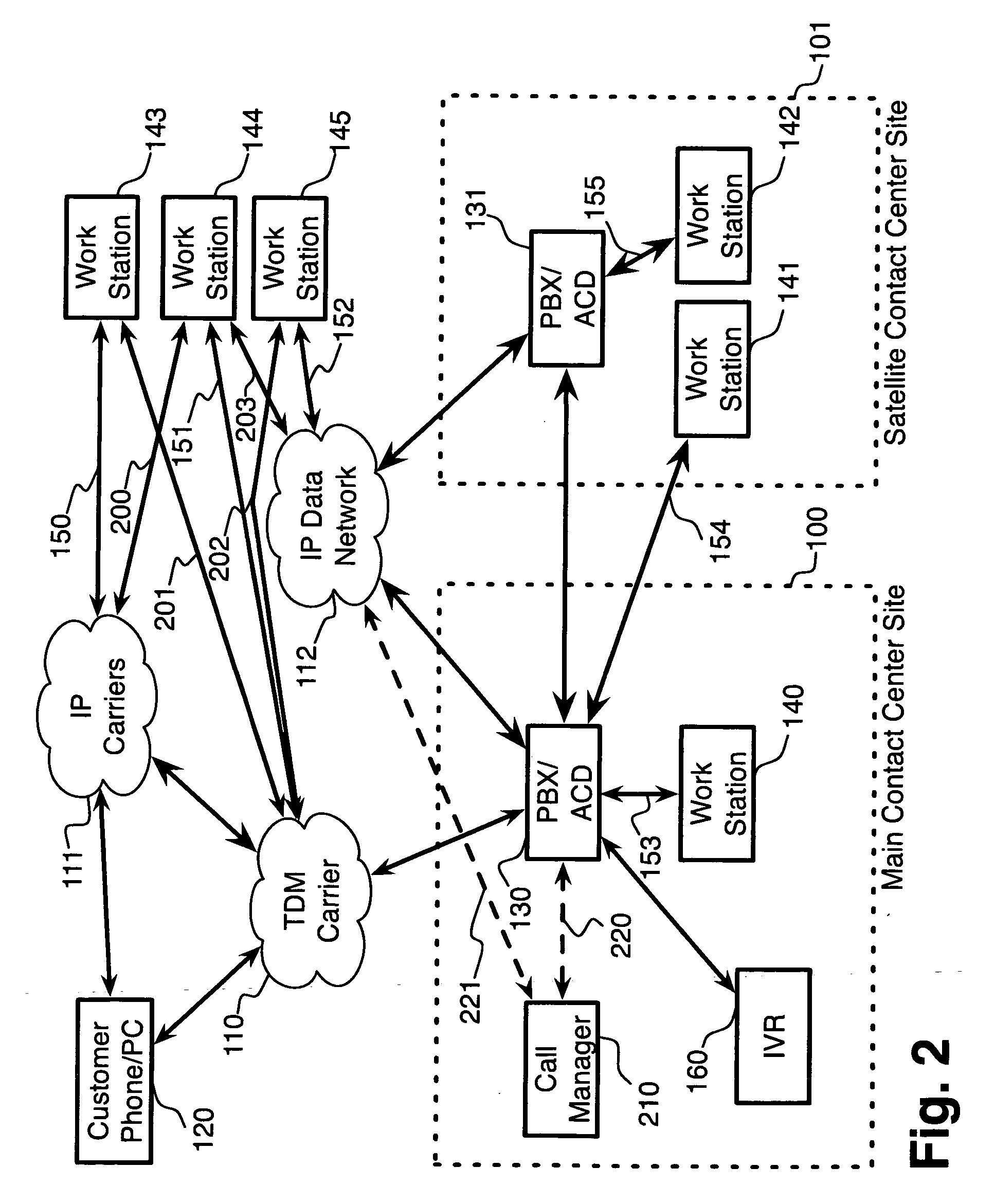[0011]In a preferred embodiment of the invention, a system for adaptive call management, comprising a network-connected call manager server and a call switching means coupled to the call manager server and adapted to deliver calls to an endpoint via at least a connection-oriented telephone and an internet protocol telephony endpoint, is disclosed. According to the embodiment, upon receipt of a call quality indicium from a call quality monitoring means associated with a media channel, the call manager server selects a specific media channel. Media channels may also be referred to as media routing paths or media paths, and may comprise one or more of a telephony call using analog or digital time-division multiplexing (TDM) telephony such as integrated services digital network (ISDN), an internet protocol (IP) telephony session, a video conference or video telephony session established using a protocol such as SIP / RTP or H.323, a streaming audio feed with or without a feedback capability, or even an instant messaging (IM) session. It will be appreciated by those having ordinary experience in the art that there are many possible individual or combined media channels (e.g., voice, video, collaborative desktop) or media routing paths that may be used to establish a synchronous, or simultaneous, two-way communications channel between two entities, without departing from the scope of the invention. According to another embodiment of the invention, the selection of a media channel is based at least in part on a cost associated with each of the available channels. In yet another embodiment of the invention, the selection of a media channel is made based at least on a comparison of the call quality indicium with an allowable range. In a further embodiment of the invention, when the call quality indicium falls outside of an acceptable range during a call, an alternate media channel is selected and the call is switched to the alternate media channel. In yet another embodiment of the invention, switching of a call from one media channel to an alternate channel is accomplished without audible indication of said switching to a call participant. In yet another embodiment of the invention, switching of a call from one media channel to an alternate channel is accomplished with audible indication of said switching to a call participant. In yet another embodiment of the invention, switching of a call from one media channel to an alternate channel is accomplished with the active involvement of a call participant. Various combinations are envisioned according to the invention; for instance, a media channel is selected, in some embodiments, by considering cost and by comparing a quality indicium to an acceptable range. Media channels comprise one or more of internet protocol telephony sessions, connection-oriented telephony circuits, ISDN circuits, videophone sessions, and the like. In some embodiments of the invention, quality indicia from more than one type of media channel are compared in order to select a media channel.
[0012]In another embodiment of the invention, a method for adaptive call management, comprising the steps of (a) obtaining an indicium of call quality from a call quality monitoring means, and (b) selecting a media channel based at least in part on the call quality indicium, is disclosed. In a further embodiment of the invention, a method for adaptive call management, comprising the steps of (a) obtaining an indicium of call quality from a call quality monitoring means, and (b) selecting a media channel based at least in part on comparing the call quality indicium to an acceptable range, is disclosed. In a further embodiment of the invention, a method for adaptive call management, comprising the steps of (a) obtaining an indicium of call quality from a call quality monitoring means, and (b) selecting a media channel based at least in part on the call quality indicium and a cost associated with each available media channel, is disclosed. Various combinations are envisioned by the inventors, for example in step (b) selecting a media channel based at least in part on the call quality indicium falling outside an acceptable range and a cost associated with each available media channel.
[0013]In another embodiment of the invention, a method for adaptive call management, comprising the steps of (a) obtaining an indicium of call quality from a call quality monitoring means, and (b) selecting a media channel based at least in part on comparing the call quality indicium to an acceptable range, and (c) when the call quality indicium falls out of an acceptable range during a call, switching the call the to an alternate media channel, is disclosed. In yet another embodiment of the invention, a method for adaptive call management, comprising the steps of (a) obtaining an indicium of call quality from a call quality monitoring means, and (b) selecting a media channel based at least in part on comparing the call quality indicium to an acceptable range, and (c) when the call quality indicium falls out of an acceptable range during a call, switching the call the to an alternate media channel, wherein the switching of a call from one media channel to an alternate media channel is accomplished without audible indication to a participant in the call, is disclosed. In yet another embodiment of the invention, a method for adaptive call management, comprising the steps of (a) obtaining an indicium of call quality from a call quality monitoring means, and (b) selecting a media channel based at least in part on comparing the call quality indicium to an acceptable range, and (c) when the call quality indicium falls out of an acceptable range during a call, switching the call the to an alternate media channel, wherein the switching of a call from one media channel to an alternate media channel is accomplished with audible indication to a participant in the call, is disclosed. In yet another embodiment of the invention, a method for adaptive call management, comprising the steps of (a) obtaining an indicium of call quality from a call quality monitoring means, and (b) selecting a media channel based at least in part on comparing the call quality indicium to an acceptable range, and (c) when the call quality indicium falls out of an acceptable range during a call, switching the call the to an alternate media channel, wherein the switching of a call from one media channel to an alternate media channel is accomplished with active participation by a participant in the call, is disclosed.
[0014]According to another preferred embodiment of the invention, a system for adaptive call management, comprising a network-connected call manager server, a quality server coupled to the call manager server, a quality monitoring means coupled to the call manager server and the quality server and adapted to monitor quality of calls, a quality database adapted to receive at least time-stamped quality indicium from the quality monitoring server, and a call switching means coupled to the call manager server and adapted to deliver calls to a selected target via a plurality of channels, is disclosed. According to the embodiment, upon receipt of a call quality indicium from the quality monitoring server, and responsive to at least one historical call indicium obtained from the quality database, the call manager server selects a media channel for the call.
[0015]According to another preferred embodiment of the invention, a system for adaptive call management, comprising a network-connected call manager server, a quality server coupled to the call manager server, a quality database adapted to receive at least time-stamped quality indicium from a quality monitoring means, and a call switching means coupled to the call manager server and adapted to deliver calls to a selected target via a plurality of channels, is disclosed. According to the embodiment, upon receipt of a plurality of call quality indicium from the quality database, the call manager server selects a media channel for the call.
[0016]According to another preferred embodiment of the invention, a system for adaptive call management, comprising a network-connected call manager server, a quality server coupled to the call manager server, a quality monitoring means coupled to the call manager server and the quality server and adapted to monitor quality of calls, a quality database adapted to receive at least time-stamped quality indicium from the quality monitoring server, and a call switching means coupled to the call manager server and adapted to deliver calls to a selected target via a plurality of media channels, is disclosed. According to the invention, the quality server, on receiving a call quality indicium from the quality monitoring server, compares the call quality indicium to at least one historical call quality indicium obtained from quality database, and the quality server computes an expected future call quality indicium based at least on the call quality indicium received from the quality monitoring server and on the at least one historical call quality indicium, and compares this future call quality indicium to an allowable range, and if the future call quality indicium falls outside of the allowable range, the quality server selects an alternate media channel.
 Login to View More
Login to View More  Login to View More
Login to View More 


